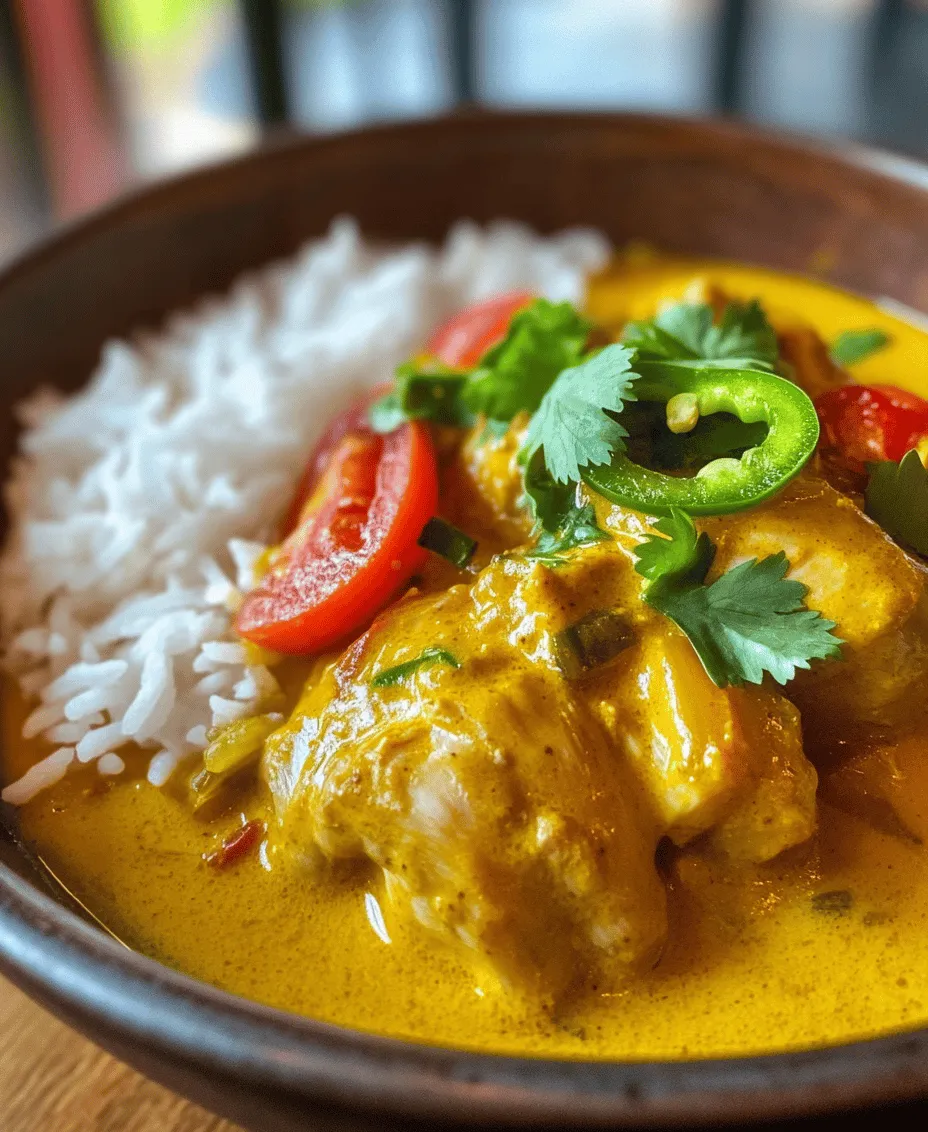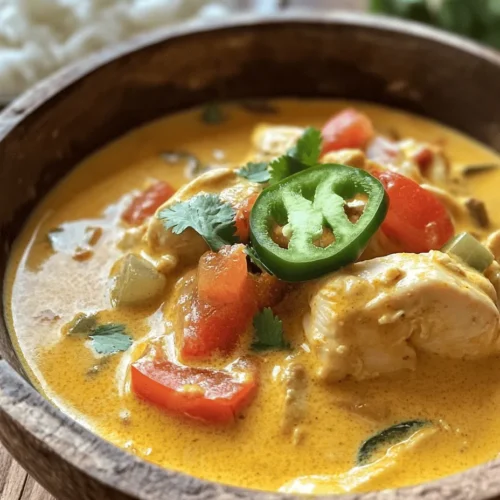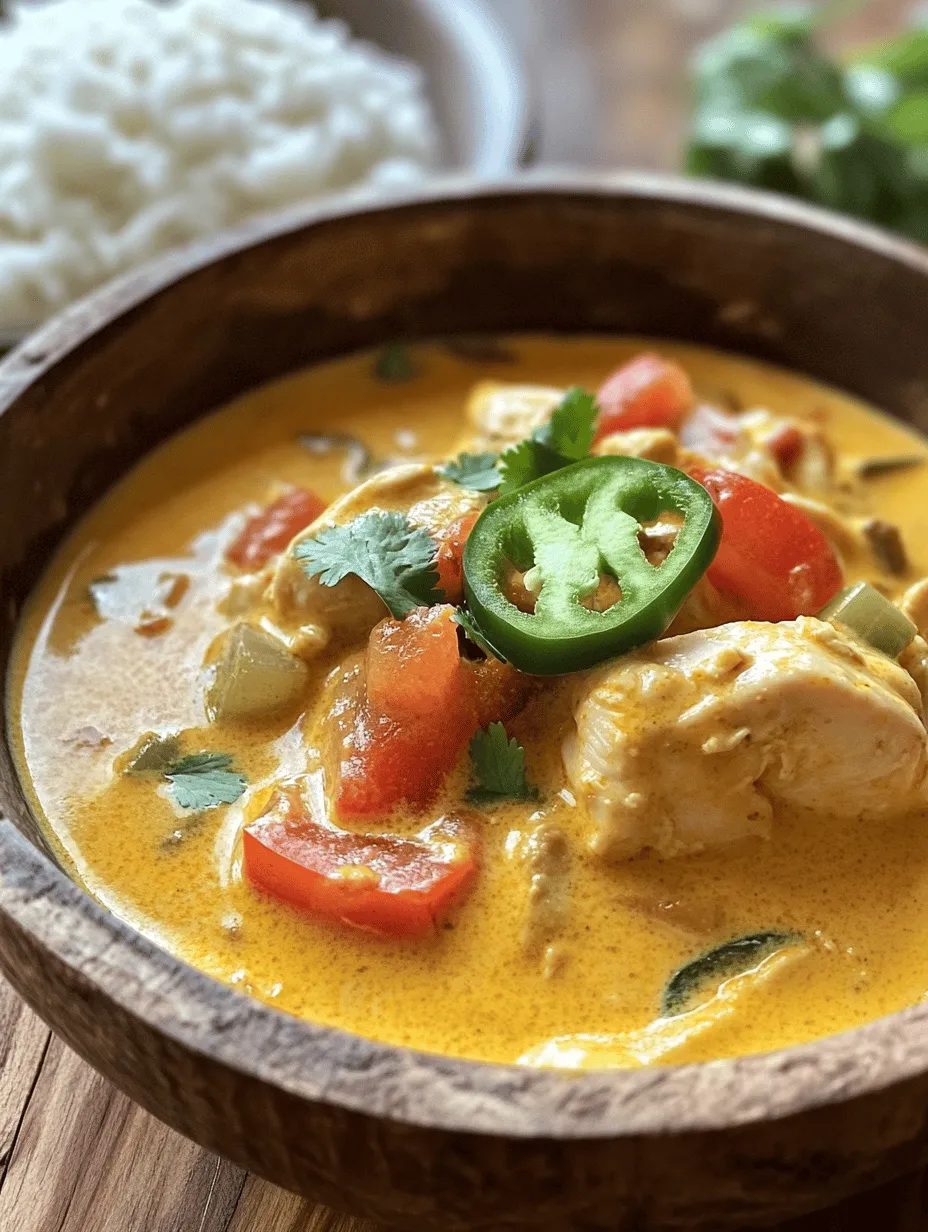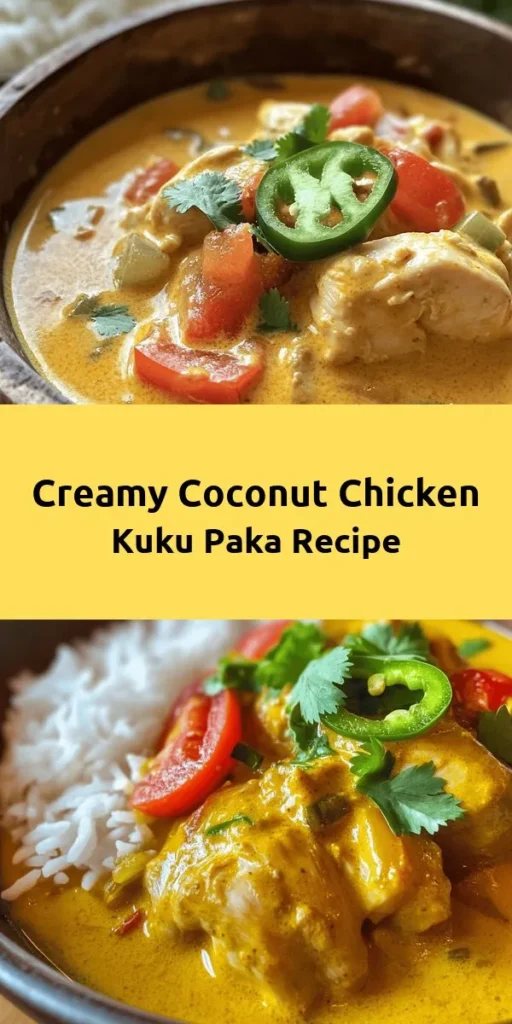Kuku Paka is a flavorful dish that beautifully combines the richness of coconut milk with tender chicken, creating a comforting meal perfect for any occasion. This delightful recipe hails from East Africa, where it has become a beloved staple due to its unique blend of spices and creamy texture. The name “Kuku Paka” translates to “chicken in coconut” in Swahili, encapsulating the essence of this dish. It not only satisfies the palate but also offers a glimpse into the vibrant culinary heritage of the region. In this article, we will delve into the origins of Kuku Paka, explore its ingredients, and provide a step-by-step cooking guide to help you recreate this delicious recipe in your own kitchen. Whether you are a seasoned chef or a beginner, Kuku Paka is a dish that is sure to impress.
Understanding Kuku Paka: The Cultural Significance of the Dish
Exploring the Origins of Kuku Paka
Kuku Paka is deeply rooted in East African cuisine, particularly in coastal regions such as Kenya and Tanzania. The dish is a product of cultural exchanges that occurred due to the historical trade routes along the Indian Ocean. As merchants from India brought their culinary traditions to East Africa, local ingredients and cooking methods began to blend with Indian spices, resulting in unique dishes like Kuku Paka.
The use of coconut milk is particularly significant in East African cooking, as coconuts are abundant in coastal areas. This creamy milk not only enhances the flavor of the dish but also adds a luxurious texture that makes Kuku Paka a comforting meal. The influence of Indian cuisine is evident in the choice of spices used in the dish. Spices such as cumin, coriander, and turmeric are staples in both Indian and East African cooking, and their incorporation into Kuku Paka gives it a distinctive taste profile that reflects this cultural fusion.
The Modern-Day Appeal of Kuku Paka
In contemporary times, Kuku Paka has gained popularity not only within East African communities but also among food enthusiasts worldwide. Its rich flavors, combined with the appealing presentation of chicken in a creamy coconut sauce, have made it a sought-after dish at gatherings and celebrations. Many families have adopted Kuku Paka into their culinary repertoire, often serving it at family gatherings, weddings, and festive occasions.
Moreover, Kuku Paka has seen numerous adaptations across various cultures. Some versions may incorporate additional ingredients, such as bell peppers or different spices, while others may modify the cooking techniques. Despite these variations, the essence of Kuku Paka remains the same—a delicious and hearty dish that brings people together over a shared love for good food.
Ingredients Breakdown: What Makes Kuku Paka Special
Essential Ingredients for Kuku Paka
To prepare Kuku Paka, you will need a selection of ingredients that work harmoniously to create its signature flavor. Here’s a breakdown of the essential ingredients:
– Chicken: The star of the dish. You can use various cuts of chicken, such as thighs, drumsticks, or boneless breast. Bone-in pieces tend to add more flavor to the dish, while boneless cuts are quicker to cook.
– Vegetables: Onions, garlic, ginger, and tomatoes are crucial for building the flavor base. Onions provide sweetness, while garlic and ginger add warmth and depth. Fresh tomatoes contribute acidity and balance the richness of the coconut milk.
– Spices: The importance of spices in Kuku Paka cannot be overstated. Ground cumin, coriander, turmeric, and chili powder lend warmth and complexity to the dish. Adjust the amount of chili powder according to your heat preference.
– Coconut Milk: This ingredient is what distinguishes Kuku Paka from other chicken dishes. Coconut milk adds creaminess and a subtle sweetness, perfectly complementing the spices and chicken.
– Fresh Herbs: Fresh cilantro and a splash of lemon juice elevate the dish with brightness and freshness. They add a finishing touch that balances the richness of the coconut milk.
Selecting the Best Ingredients
Choosing high-quality ingredients is vital for achieving the best results in your Kuku Paka. Here are some tips to ensure you select the finest components for your dish:
– Chicken: Look for fresh, organic chicken whenever possible. Bone-in pieces will provide more flavor, while skinless options can reduce the fat content if desired. Ensure the chicken is free from any unpleasant odors, and check for a vibrant color.
– Vegetables: Opt for fresh vegetables that are firm and free from blemishes. Onions should be firm and without any soft spots, while garlic should be plump with a papery skin. Choose ripe tomatoes with a deep color and a pleasant aroma.
– Spices: For authentic flavors, consider sourcing spices from local markets or specialty stores that cater to East African or Indian cooking. Freshly ground spices always yield better flavor than pre-ground varieties, so if possible, grind your spices just before use.
Step-by-Step Cooking Instructions for Kuku Paka
Marinating the Chicken: Building Flavor
Marination is a crucial step in preparing Kuku Paka, as it allows the flavors of the spices to penetrate the meat. To marinate the chicken effectively, follow these steps:
1. Prepare the Marinade: In a mixing bowl, combine yogurt, minced garlic, grated ginger, ground cumin, coriander, turmeric, chili powder, and salt. The yogurt not only adds flavor but also helps to tenderize the chicken.
2. Coat the Chicken: Add the chicken pieces to the marinade, ensuring they are thoroughly coated. This step is essential for infusing the chicken with the rich flavors of the spices.
3. Marination Time: Allow the chicken to marinate for at least 30 minutes. For optimal flavor, refrigerate it for several hours or overnight. The longer the chicken marinates, the more intense the flavors will be.
Cooking the Base: Creating a Flavorful Foundation
Once the chicken is marinated, it’s time to prepare the base for Kuku Paka. This involves sautéing key ingredients to build a flavor foundation:
1. Sauté Onions: In a large skillet or pot, heat a few tablespoons of oil over medium heat. Add finely chopped onions and sauté until they become translucent and start to caramelize. This step usually takes about 5-7 minutes.
2. Add Garlic and Ginger: Stir in the minced garlic and grated ginger, cooking for an additional minute until fragrant. Be careful not to burn the garlic, as it can turn bitter.
3. Incorporate Tomatoes: Add chopped tomatoes to the skillet and cook until they break down and form a thick sauce. This process typically takes about 5 minutes. The tomatoes will add acidity and moisture to the dish.
4. Introduce the Spices: Sprinkle in the marinated spices and cook for a couple of minutes, allowing the spices to bloom and release their flavors into the base.
By following these steps, you will create a flavorful foundation for your Kuku Paka, setting the stage for the chicken to absorb all the deliciousness. In the next part of this article, we will continue with the cooking process, culminating in the creation of this creamy coconut chicken delight. Stay tuned for the final steps that will bring Kuku Paka to life on your dinner table.

How to Properly Toast Spices for Maximum Flavor
Toasting spices is a crucial step in creating a fragrant and flavorful Kuku Paka. This technique enhances the natural oils in the spices, unlocking their full potential. To properly toast your spices, follow these steps:
1. Select Your Spices: Common spices for Kuku Paka include cumin seeds, coriander seeds, and black peppercorns. Use whole spices whenever possible for the best flavor.
2. Heat Your Pan: Place a dry skillet over medium heat. Make sure the pan is clean and completely dry, as moisture can hinder the toasting process.
3. Add the Spices: Once the pan is hot, add the spices. Stir them frequently to prevent burning. You should start to smell their aromatic scent within a minute or two.
4. Watch for Color Change: The spices are ready when they become slightly darker in color, usually within 3 to 5 minutes. Remove them from the heat immediately to prevent over-toasting, which can lead to bitterness.
5. Cool and Grind: Let the toasted spices cool before grinding them into a fine powder using a mortar and pestle or a spice grinder. Freshly ground spices can significantly elevate the flavor of your Kuku Paka.
Adding the Chicken and Coconut Milk: The Heart of the Dish
With your spices prepared, it’s time to add the chicken and coconut milk, which are integral to Kuku Paka’s creamy texture and rich flavor.
Tips for Browning the Chicken Effectively
1. Use the Right Pan: A heavy-bottomed skillet or Dutch oven is best for even cooking and browning.
2. Preheat the Oil: Heat a couple of tablespoons of oil in the pan over medium-high heat. The oil should shimmer but not smoke.
3. Don’t Overcrowd the Pan: Add the chicken pieces in batches if necessary. Overcrowding can lower the temperature of the pan, causing the chicken to steam instead of brown.
4. Let it Cook: Allow the chicken to brown on one side without moving it for about 5-7 minutes before flipping. This helps achieve a nice crust.
5. Season as You Go: Sprinkle some salt and pepper on the chicken as it cooks to infuse the flavor as it browns.
The Right Way to Incorporate Coconut Milk for a Creamy Consistency
Once the chicken is nicely browned, it’s time to add the coconut milk.
1. Deglaze the Pan: After the chicken has browned, deglaze the pan by adding a splash of water or chicken broth, scraping up the flavorful browned bits from the bottom.
2. Add Coconut Milk: Pour in the full-fat coconut milk, stirring to combine. This not only adds creaminess but also balances the spices.
3. Mix Thoroughly: Ensure that the coconut milk is evenly distributed throughout the chicken and spices. This will help create a cohesive sauce.
Simmering to Perfection: Ensuring Tender Chicken
The simmering stage is critical for achieving tender chicken and allowing the flavors to meld.
Recommended Cooking Times and How to Check for Doneness
1. Simmer Gently: Bring the mixture to a gentle simmer. If the heat is too high, the coconut milk may separate, resulting in an undesirable texture.
2. Cooking Duration: Allow the chicken to simmer uncovered for about 25-30 minutes. If you’re using bone-in chicken, it may require a bit longer, around 35-40 minutes.
3. Check for Doneness: To check if the chicken is cooked through, insert a meat thermometer into the thickest part. The internal temperature should reach 165°F (74°C). Alternatively, cut into a piece; the juices should run clear, and the meat should no longer be pink.
Adjusting Seasoning for Personal Preference
As the Kuku Paka simmers, taste and adjust the seasoning to your liking:
1. Salt and Pepper: A pinch of salt can enhance the dish’s overall flavor. Start with a small amount and adjust as needed.
2. Add Spice: If you prefer a little heat, consider adding a finely chopped chili or a pinch of cayenne pepper for an extra kick.
3. Balance Flavors: If the dish tastes too rich, a squeeze of fresh lime or lemon juice can brighten the flavors and enhance the coconut’s sweetness.
Finishing Touches: Garnishing and Serving Suggestions
Once the chicken is tender and flavorful, it’s time to finish the dish with some garnishes and prepare for serving.
How to Incorporate Cilantro and Optional Garnishes
1. Chop Fresh Cilantro: Finely chop fresh cilantro leaves and sprinkle them generously over the Kuku Paka for a burst of color and freshness.
2. Optional Garnishes: Consider adding sliced green chilies or a sprinkle of toasted coconut flakes for added texture and flavor. A dollop of yogurt can also provide a creamy contrast, if desired.
Best Accompaniments for Serving Kuku Paka
Kuku Paka shines when paired with traditional sides that complement its flavors:
1. Steamed Rice: Serve the dish over a bed of fluffy steamed white or brown rice, allowing the creamy sauce to soak into the grains.
2. Ugali: This staple dish of East Africa is a dense, dough-like accompaniment made from maize flour. It pairs wonderfully with the sauce and can be used to scoop up the chicken.
3. Chapati: Soft, flaky flatbreads like chapati are perfect for mopping up the sauce and add another layer of texture to your meal.
Creative Serving Ideas
When it comes to presenting Kuku Paka, consider these tips to make your dish visually appealing:
1. Plating: Use a large serving platter to showcase the Kuku Paka. Arrange the chicken pieces artfully and pour the coconut sauce over them.
2. Garnish Thoughtfully: Arrange cilantro sprigs and optional garnishes around the dish. A sprinkle of chili flakes or grated coconut can add a pop of color.
3. Family-Style Dining vs. Individual Servings: For a more communal experience, serve the Kuku Paka in a large bowl at the center of the table. Alternatively, plate individual servings for a more formal presentation.
Nutritional Information: Understanding the Health Benefits of Kuku Paka
Kuku Paka is not only delicious but also offers several health benefits due to its wholesome ingredients.
Evaluating the Nutritional Content
A typical serving of Kuku Paka (approximately 1 cup) contains:
– Calories: 400-450 kcal
– Protein: 30-35 grams
– Fat: 25 grams (mostly from coconut milk, which contains healthy fats)
Coconut milk is rich in medium-chain triglycerides (MCTs), which may provide quick energy and support weight management.
Health Benefits of Coconut Milk and Spices Used in the Recipe
1. Coconut Milk: This creamy ingredient is known for its anti-inflammatory properties and can support heart health. It also contains vitamins C, E, and several B vitamins.
2. Spices: The spices used, such as turmeric, cumin, and coriander, are known for their antioxidant properties and potential digestive benefits. Turmeric, in particular, has been studied for its anti-inflammatory effects.
Incorporating Kuku Paka into a Balanced Diet
Kuku Paka can easily fit into a balanced diet. Here are some suggestions:
1. Meal Planning: Include Kuku Paka in your weekly meal prep. It can be made in advance and stored in the refrigerator for up to three days, making it a convenient choice for busy nights.
2. Making Kuku Paka Healthier: For a lighter version, consider using skinless chicken or substituting half of the coconut milk with low-fat yogurt. This can reduce the overall fat content while still maintaining a creamy texture.
Conclusion: The Joy of Cooking and Sharing Kuku Paka
Kuku Paka is not just a dish; it is a celebration of flavors and cultures that brings people together. By understanding its origins, ingredients, and preparation methods, anyone can master this delightful recipe. Whether enjoyed on a special occasion or as a comforting weeknight meal, Kuku Paka is sure to become a favorite in your household. Embrace the experience of cooking this creamy coconut chicken delight and share the joy of East African cuisine with others. With its rich flavors and inviting aroma, Kuku Paka is bound to bring smiles to your table and create lasting memories.



